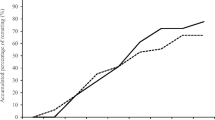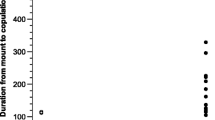Abstract
We investigated the lifetime mating potential and the reproductive behavior of male and female turnip moths Agrotis segetum (Schiff.) under field and laboratory conditions. The sex ratio was 1 : 1 in a lab-reared population as well as in two wild populations. Males were capable of mating repetitively a relatively large number of times (mean of 6.7 ± 2.7 matings) when given access to new virgin females throughout their lifetimes. Females seldom mated more than once (mean ± 1.3 ± 0.6 matings), indicating a male-biased operational sex ratio. The mean potential lifetime mating was five times higher in males, while the coefficient of variance was lower in males. There was no differences in longevity between animals that were allowed to mate and animals not allowed to mate, indicating no direct costs or benefits of mating in physiological terms. In males, the number of matings was positively correlated with longevity, but this was not the case in females. Nor was there a correlation between the number of female matings and the number of fertilized eggs. There was a negative correlation between the number of eggs fertilized and the number of times males had previously mated, indicating that male ejaculates were limited. Male spermatophore size also decreased with number of achieved matings. Laboratory-reared females attracted males in the field throughout their lifetimes, with a peak at 3–7 days of age. Wild males, allowed to choose between pairs of caged females in the field, were attracted in equal numbers to females of different ages. Females did not show any mate-rejection behavior in the field. They mated with the first male that courted them. No incidence of mate replacement by males arriving later to already courted females were recorded.
Similar content being viewed by others
REFERENCES
Acharya, L. (1995). Sex-biased predation on moths by insectivorous bats. Anim. Behav. 49: 1461–1468.
Anderbrant, O., Löfqvist, J., Jönsson, J., and Marling, E. (1989). Effects of pheromone trap type, position and colour on the catch of the pine sawfly Neodiprion sertifer (Geoff.) (Hym., Diprionidae). J. Appl. Entomol. 107: 365–369.
Andersson, M. (1994). Sexual Selection, Princeton University Press, Princeton, NJ.
Arn, H., Esbjerg, P., Bues, R., Tòth, M., Szöcs, G., Guerin, P., and Rauscher, S. (1983). Field attraction of Agrotis segetum males in four European countries to mixtures containing three homologous acetates. J. Chem. Ecol. 9: 267–276.
Arn, H., Tòth, M., and Priesner, E. (1992). List of sex pheromones of Lepidoptera and related attractants. IOBC WPRS/OILB-SROP.
Choe, J. C. and Crespi, B. J. (1997). The Evolution of Mating Systems in Insects and Arachnids, Cambridge University Press, Cambridge.
Boggs, C. L., and Gilbert, L. E. (1979). Male contribution to egg production in butterflies: First evidence for transfer of nutrients at mating. Science 206: 83–84.
Braby, M. F., and Jones, R. E. (1995). Reproductive patterns and resource allocation in tropical butterflies: Influence of adult diet and seasonal phenotype on fecundity, longevity and egg size. Oikos 72: 189–204.
Callahan, P. S., and Cascio, T. (1963). Histology of the reproductive tracts and transmission of sperm in the corn earworm, Heliothis zea. Ann. Entomol. Soc. Am. 56: 535–556.
Callahan, P. S., and Chapin, J. B. (1960). Morphology of the reproductive systems and mating in two representative members of the family Noctuidae, Pseudaletia unipuncta and Peridroma margaritosa with comparison to Heliothis zea. Ann. Entomol. Soc. Am. 53: 763–782.
Calow, P. (1979). The cost of reproduction: A physiological approach. Biol. Rev. 54: 23–40.
Carter, D. J. (1984). Pest Lepidoptera of Europe with special reference to the British Isles. Series Entomologica 31, Junk, Dordrecht.
Cordts, R., and Partridge, L. (1996). Courtship reduces longevity of male Drosophila melanogaster. Anim. Behav. 52: 269–278.
Delisle, J., and Bouchard, A. (1995). Male larval nutrition in Choristoneura rosaceana (Lepidoptera: Tortricidae): An important factor in reproductive success. Oecologia 104: 308–314.
Dewsbury, D. A. (1982). Ejaculate cost and male choice. Am. Nat. 119: 601–610.
Eberhard, W. G. (1977). Aggressive chemical mimicry by a bolas spider. Science 198: 1173–1175.
Emlen, S. T., and Oring, L. W. (1977). Ecology, sexual selection, and the evolution of mating systems. Science 197: 215–223.
Esbjerg, P. (1987). The influence of diurnal time and weather on sex trap catches of the turnip moth Agrotis segetum Schiff. Lepidoptera Noctuidae. J. Appl. Entomol. 103: 177–184.
Fitzpatrick, S., and McNeil, J. N. (1989). Lifetime mating potential and reproductive success in males of the true armyworm, Pseudaletia unipuncta (Haw.) (Lepidoptera: Noctuidae). Funct. Ecol. 3: 37–44.
Foster, S. P., and Ayers, R. H. (1996). Multiple matings and its effects in the lightbrown apple moth, Epiphyas postvittana (Walker). J. Insect Physiol. 42(7): 657–667.
Greenfield, M. D. (1981). Moth sex pheromones: An evolutionary perspective. Fla. Entomol. 64: 4–17.
Hinks, C. F., and Byers, J. R. (1976). Biosystematics of the genus Euxoa (Lepidoptera: Noctuidae). V. Rearing procedures and life cycles of 36 species. Can. Entomol. 108: 1345–1358.
Howlader, M. A., and Gerber, G. H. (1986). Effects of age, egg development, and mating on calling behavior of the bertha armyworm, Mamestra configurata Walker (Lepidoptera: Noctuidae). Can. Entomol. 118: 1221–1230.
Karlsson, B., and Wickman, P.-O. (1989). The cost of prolonged life, an experiment on a lymphalid butterfly. Funct. Ecol. 3: 399–406.
Lloyd, J. E. (1979). Sexual selection in luminescent beetles. In Blum, M. S., and Blum, N. A. (eds.), Sexual Selection and Reproductive Competition in Insects, Academic Press, New York, pp. 293–342.
Löfstedt, C., Van der Pers, J. N. C., Löfqvist, J., Lanne, B. S., Appelgren, M., Bergström, G., and Thelin, B. (1982). Sex pheromone components of the turnip moth, Agrotis segetum. J. Chem. Ecol. 8: 1305–1321.
Miller, J. R., and Roelofs, W. L. (1977). Sex pheromone titer correlated with pheromone gland development and age in the redbanded leafroller moth, Argyrotaenia velutinana. Ann. Entomol. Soc. Am. 70: 136–139.
Norusis, M. J. (1994). SPSS 6.1 Base System User's Guide, SPSS, Chicago.
Rogers, C. E., and Marti, O. G. (1994). Effects of age at first mating on their reproductive potential of the fall armyworm (Lepidoptera: Noctuidae). Environ. Entomol. 23: 322–325.
Rohlften, K., Friese, G., and Hülbert, D. (1990). Bibliographie über die Wintersaateule, Agrotis segetum Denis and Schiffermüller (Lepidoptera: Noctuidae). Beitr. Entomol. 2: 407–467.
Rutowski, R. L. (1982). Epigamic selection by males as evidenced by courtship partner preferences in the checkered white butterfly (Pieris protodice). Anim. Behav. 30: 108–112.
Rutowski, R. L., Gilchrist, G. W., and Terkanian, B. (1987). Female butterflies mated with recently mated males show reduced reproductive output. Behav. Ecol. Sociobiol. 20: 319–322.
Sokal, R. R., and Rohlf, F. J. (1995). Biometry, 3rd ed., Freeman, New York.
Stanley-Samuelsson, D. W., and Loher, W. (1986). Prostaglandins in insect reproduction. Ann. Entomol. Soc. Am. 79: 841–853.
Roff, D. A. (1992). The Evolution of Life Histories, Chapman & Hall, New York.
Svensson, M. (1996). Sexual selection in moths: The role of chemical communication. Biol. Rev. 71: 113–135.
Svensson, M. G. E., Bengtsson, M., and Löfqvist, J. (1997). Individual variation and repeatability of sex pheromone emission of female turnip moths Agrotis segetum. J. Chem. Ecol. 23: 1833–1850.
Szöcs, G., Tòth, M., and Novak, L. (1983). Sex attractants and inhibitors for lepidopterous species found by field screening of olefinic compounds in Hungary. Z. Angew. Entomol. 96: 56–76.
Thornhill, R., and Alcock, J. (1983). The Evolution of Insect Mating Systems, Harvard University Press, Cambridge, MA.
Trivers, R. L. (1972). Parental investment and sexual selection. In Campbell, B. (ed.), Sexual Selection and the Descent of Man, 1871–1971, Heinemann, London, pp. 136–179.
Wiklund, C., and Fagerström, T. (1977). Why do males emerge before females? A hypothesis to explain the incidence of protandry in butteflies? Oecologia 31: 153–158.
Author information
Authors and Affiliations
Rights and permissions
About this article
Cite this article
Svensson, M.G.E., Marling, E. & Löfqvist, J. Mating Behavior and Reproductive Potential in the Turnip Moth Agrotis segetum (Lepidoptera: Noctuidae). Journal of Insect Behavior 11, 343–359 (1998). https://doi.org/10.1023/A:1020998513316
Issue Date:
DOI: https://doi.org/10.1023/A:1020998513316




